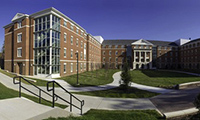Virginia State University’s Gateway Hall Earns LEED Gold
 PETERSBURG, Va. — Clark Nexsen, an architecture firm headquartered in Norfolk, Va., announced earlier this month that Virginia State University’s (VSU) Gateway Hall earned LEED Gold certification. The 135,000-square-foot residence hall, which opened in 2012, is the first VSU facility to earn LEED Gold certification for its comprehensive energy-efficient features.
PETERSBURG, Va. — Clark Nexsen, an architecture firm headquartered in Norfolk, Va., announced earlier this month that Virginia State University’s (VSU) Gateway Hall earned LEED Gold certification. The 135,000-square-foot residence hall, which opened in 2012, is the first VSU facility to earn LEED Gold certification for its comprehensive energy-efficient features.
The 586-bed residence hall serves returning and graduate student. It features a computer lab, multipurpose room, game room, wellness center, and laundry facilities. Clark Nexsen designed the four-story building, while Newport News, Va.-headquartered W.M. Jordan Company served as the construction manager on the project.
The U.S. Green Building Council gave the facility special innovation credits as part of the LEED Gold rating for exemplary performance in maximized open space, daylighting and views and water efficiency.
The project’s sustainable features include heating, air conditioning, lighting and other systems designed to maximize energy performance that result in a 21 percent reduction of energy usage. More than half of the site was preserved to provide green space with pedestrian walkways and expansive lawn areas that can be used by students. More than 84 percent of the interior space has access to daylight and 95 percent of the interior space has a view to the outside.
Other highlights include low-flow faucets, showerheads and dual-flush toilets that reduce the annual water usage by 50 percent. More than 96 percent of the total waste generated during construction was diverted away from landfills, allowing for the recovery of recyclable and reusable materials. Low VOC (volatile organic compounds) products were used throughout the building to protect indoor air quality and maintain a healthier dorm environment. The stormwater management plan minimizes stormwater run-off and reduces stream erosion — returning the site hydrology to its pre-construction condition.
To help reduce the carbon footprint, more than 40 percent of the construction materials used in the facility were extracted and manufactured within 500 miles of the project. Optimum insulation, energy-efficient lighting, high-performance window assemblies, energy-recovery ventilator units, and lighting occupancy sensors help to conserve energy use.
In addition to sustainability initiatives, the project was also completed efficiently. W. M. Jordan Company used panelized wall construction to expedite construction, improving construction quality with higher quality building components and schedule control. This was made possible with a thorough BIM coordination effort, supported by the entire project team, followed by proper inspections to confirm quality of installation.
